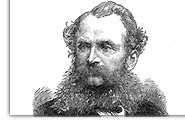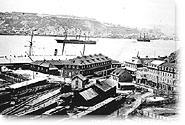Lévis, A sentinel of Québec... and of the Empire
Lévis Forts National Historic Site

William Drummond Jervois
© The Illustrated London News / 10th April 1875
Since 1862 all reports had been unanimous. Point Lévy had to be fortified. In 1862 London sent assistant inspector general William Drummond Jervois out to the colony to design a new defence strategy. It became apparent to Jervois that the Yankees would invade Canada and that there was an urgent need to set up a stronger network of defence. If the British troops were forced to retreat, the port of Québec would be their last refuge.

Grand Trunk Railway in Lévis, around 1865
© National Archives of Québec / P1000, S4, D60, P12
Defending the harbour at Québec was more of an imperial than a colonial issue, because the British wanted to ensure the movement of their fleet in and out of the port at all costs. Since there was now a rail connection from Lévis to Maine, the border was very vulnerable. The British defensive forces would no longer be able to hold back the Americans and the port of Québec was at risk. It was therefore decided to build a fort on the ridge at Point Lévy.
The English Parliament consequently voted to release funds for the construction of a network of detached forts that would fend off the enemy to the south and complement the defensive system on the north shore of the St. Lawrence. Point Lévy was to become a sentinel of Québec, and indeed, of the Empire.
The original plan called for five forts all facing the United States. However, the fifth fort which was planned as an outpost, a redoubt and a command post serving the forts further east, was finally dropped from the scheme. Finally only three forts were to form a semicircle 1800 meters apart. Jervois chose three different polygon shapes for the forts and had them located so that firing from one fort would cover the firing from the next. The ditches were defended by caponiers. The artillery were to fight out in the open. Fort No. 1 was the farthest east and overlooked Île d'Orléans and the port of Québec. It was to assist the Citadel at Québec in defending the St. Lawrence.
- Date modified :